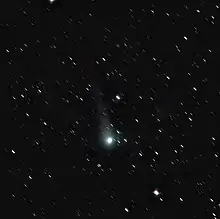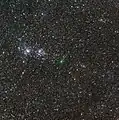C/2017 T2 (PanSTARRS)
C/2017 T2 (PanSTARRS) is an Oort cloud comet discovered on 2 October 2017[3] when it was 9.2 AU (1.38 billion km) from the Sun. The closest approach to Earth was on 28 December 2019 at a distance of 1.52 AU (227 million km). It came to perihelion (closest approach to the Sun) on 4 May 2020[2] when it was safe from disintegration at 1.6 AU from the Sun. (Mars is also roughly 1.6 AU from the Sun.)
 | |
| Discovery | |
|---|---|
| Discovered by | Pan-STARRS |
| Discovery date | 2 October 2017 |
| Orbital characteristics | |
| Epoch | 2458756.5 (30 Sept 2019) |
| Observation arc | 3.93 years |
| Number of observations | 6896 |
| Orbit type | Oort cloud |
| Aphelion | ~74000 AU (inbound)[1] ~3000 AU (outbound) |
| Perihelion | 1.6150 AU |
| Eccentricity | 0.99971 |
| Orbital period | ~7 million years (inbound)[1] ~55000 years (outbound) |
| Inclination | 57.232° |
| Last perihelion | 4 May 2020[2] |
| Earth MOID | 1.2 AU (180 million km; 470 LD) |
| Jupiter MOID | 0.99 AU (148 million km; 390 LD) |
Comet C/2017 T2 (PanSTARRS) brightened to apparent magnitude 8 and was visible with 50mm binoculars.[4][5] On 22-24 May 2020, the comet passed near the galaxy pair of Messier 81 and Messier 82, passing less than one degree from the latter.[6] In early June 2020 the comet was near the magnitude 1.8 star Dubhe in Ursa Major.[7]
Based on the light curve of the comet nucleus, it has been estimated that the nucleus has a rotational period of 5.6759 ± 0.0046 h.[8] The comet at perihelion had a water production of 6×1028 molecules/s. Also when observed in CN featured two side jets in June 2020, but they weren't observed one month later.[9] Concentric structures were observed in the inner coma in May 2020, probably created by a jet with rotation axis towards the Earth.[10]
JPL Horizons using an epoch 1950 orbit solution models that C/2017 T2 took millions of years to come from the Oort cloud at a distance of roughly 74,000 AU (1.2 ly).[1]
 C/2017 T2 (right) passing near Messier 81 and Messier 82 on May 22, 2020
C/2017 T2 (right) passing near Messier 81 and Messier 82 on May 22, 2020 C/2017 T2 (centre) passing near the Double Cluster on January 23, 2020
C/2017 T2 (centre) passing near the Double Cluster on January 23, 2020
References
- Horizons output. "Barycentric Osculating Orbital Elements for Comet C/2017 T2 (PANSTARRS)". Solution using the Solar System Barycenter. Ephemeris Type:Elements and Center:@0 (To be outside planetary region, inbound epoch 1950 and outbound epoch 2050. For epoch 1950-Jan-01 orbit period is "PR= 2.6E+09 / 365.25 days" = ~7.1 million years)
- "JPL Small-Body Database Browser: C/2017 T2 (PANSTARRS)". Jet Propulsion Laboratory. Retrieved 27 May 2020.
- Weryk, R.; Sato, H.; Wainscoat, R. J.; Woodworth, D.; Micheli, M.; Soulier, J. -F. (1 October 2017). "Comet C/2017 T2 (Panstarrs)". Central Bureau Electronic Telegrams. 4445: 1. Bibcode:2017CBET.4445....1W.
- "Comet Observation database (COBS)". Retrieved 27 May 2020. "C/2017 T2 (PANSTARRS) plot"
- Seiichi Yoshida. "C/2017 T2 ( PanSTARRS )". Retrieved 27 May 2020.
- Lawrence, Pete (1 May 2020). "How to see and photograph comet C/2017 T2 PanSTARRS". BBC Sky at Night Magazine. Retrieved 14 February 2023.
- Dickinson, David (13 February 2020). "Catch Comet T2 PanSTARRS This Spring". Universe Today. Retrieved 14 February 2023.
- Bahyl, Vladimír; Balážová, Emília (1 January 2022). "Comet C/2017 T2 (PanSTARRS): Nucleus Lightcurve and Period". Minor Planet Bulletin. 49 (1): 59–60. Bibcode:2022MPBu...49...59B. ISSN 1052-8091.
- Schleicher, D. G.; Knight, M. M.; Skiff, B. A. (1 October 2020). "A Smorgasbord of Recent Comet Narrowband Imaging and Photometry: Results from NEOWISE (C/2020 F3), ATLAS (C/2019 Y4), PanSTARRS (C/2017 T2), and 88P/Howell". Aas/Division for Planetary Sciences Meeting Abstracts. Vol 52. 52 (6): 111.05. Bibcode:2020DPS....5211105S.
- Manzini, Federico; Ochner, Paolo; Oldani, Virginio; Bedin, Luigi R. (2 May 2020). "ATel #13698: Concentric structures in the inner coma of comet C/2017 T2 (PANSTARRS)". The Astronomer's Telegram.

.png.webp)


_on_Jul_14_2020_aligned_to_stars.jpg.webp)